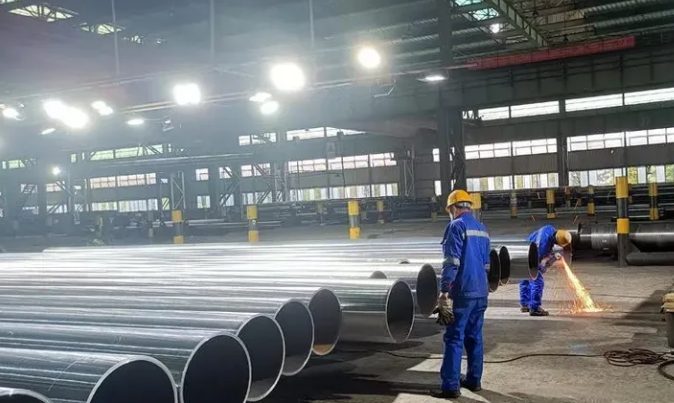
Quality Control and Inspection of Welded Steel Pipes
Date:2024-03-04 keywords: welded steel pipe quality control, welded pipe quality inspection, non-destructive testing
Quality control measures during the production process of welded steel pipes are an important step to ensure that products meet standard requirements. These measures mainly focus on raw material selection, production process control, welding process monitoring and finished product inspection to ensure that the quality and performance of welded steel pipes meet design standards.
2. Production process control: Welded steel pipes (such as ERW welded pipes) need to strictly control various process parameters during the production process, such as welding temperature, welding speed, current and voltage, etc. Use advanced welding equipment and processes to ensure welding quality and consistency.
3. Welding process monitoring: During the welding process, real-time monitoring and control are required, as well as timely correction of possible problems. Use automated monitoring equipment to monitor welding temperature, welding energy, weld quality, etc. to ensure the stability and reliability of the welding process.
4. Finished product inspection: The finished product of welded steel pipe needs to be comprehensively inspected, including weld inspection, dimensional inspection, mechanical property testing, etc. In finished product inspection, a combination of non-destructive testing and destructive testing is usually used to ensure product quality.
Now let’s discuss the role of non-destructive testing and destructive testing in welded steel pipe quality inspection:
1. Non-destructive testing:
Ultrasonic testing: Using ultrasonic detection equipment to detect welds, welding defects such as pores, cracks, etc. can be found without damaging the pipe. This method is very effective in finding internal defects and ensuring the non-destructive quality of welded steel pipes.
X-ray inspection: irradiate the weld with X-rays and detect welding defects through the received radiographic images. X-ray inspection is very effective in detecting structural defects and unevenness in welds and is a commonly used non-destructive inspection method.
2. Destructive testing:
Tensile test: Conduct tensile test on welded steel pipe samples to test its tensile strength, yield strength, elongation and other mechanical properties. This destructive test evaluates the strength and reliability of welded steel pipes.
Hardness test: Conduct hardness test on the weld and its surrounding area to detect the hardness distribution and evaluate the strength and hardness uniformity of the welding area. Hardness testing is an important means to evaluate the structure and performance of welds.
Non-destructive testing and destructive testing play complementary roles in welded steel pipe quality inspection. The former can detect and repair internal defects in time to ensure product quality; the latter comprehensively evaluates the mechanical properties and organizational structure of welded steel pipes to ensure that the mechanical properties of the product meet the design requirements. Through the comprehensive application of these detection methods, we can ensure that the quality of welded steel pipes meets standard requirements and ensure their safe and reliable use.
1. Raw material selection: For the production of welded steel pipes, selecting high-quality steel plates and pipes is key. The chemical composition and mechanical properties of the raw materials need to comply with relevant standards, and strict quality inspections are conducted to ensure the weldability and mechanical properties of the raw materials.

2. Production process control: Welded steel pipes (such as ERW welded pipes) need to strictly control various process parameters during the production process, such as welding temperature, welding speed, current and voltage, etc. Use advanced welding equipment and processes to ensure welding quality and consistency.
3. Welding process monitoring: During the welding process, real-time monitoring and control are required, as well as timely correction of possible problems. Use automated monitoring equipment to monitor welding temperature, welding energy, weld quality, etc. to ensure the stability and reliability of the welding process.
4. Finished product inspection: The finished product of welded steel pipe needs to be comprehensively inspected, including weld inspection, dimensional inspection, mechanical property testing, etc. In finished product inspection, a combination of non-destructive testing and destructive testing is usually used to ensure product quality.
Now let’s discuss the role of non-destructive testing and destructive testing in welded steel pipe quality inspection:
1. Non-destructive testing:
Ultrasonic testing: Using ultrasonic detection equipment to detect welds, welding defects such as pores, cracks, etc. can be found without damaging the pipe. This method is very effective in finding internal defects and ensuring the non-destructive quality of welded steel pipes.
X-ray inspection: irradiate the weld with X-rays and detect welding defects through the received radiographic images. X-ray inspection is very effective in detecting structural defects and unevenness in welds and is a commonly used non-destructive inspection method.
2. Destructive testing:
Tensile test: Conduct tensile test on welded steel pipe samples to test its tensile strength, yield strength, elongation and other mechanical properties. This destructive test evaluates the strength and reliability of welded steel pipes.
Hardness test: Conduct hardness test on the weld and its surrounding area to detect the hardness distribution and evaluate the strength and hardness uniformity of the welding area. Hardness testing is an important means to evaluate the structure and performance of welds.
Non-destructive testing and destructive testing play complementary roles in welded steel pipe quality inspection. The former can detect and repair internal defects in time to ensure product quality; the latter comprehensively evaluates the mechanical properties and organizational structure of welded steel pipes to ensure that the mechanical properties of the product meet the design requirements. Through the comprehensive application of these detection methods, we can ensure that the quality of welded steel pipes meets standard requirements and ensure their safe and reliable use.
News Update :
Why Must Seamless Pipes Undergo Heat Treatment?...
©2017 Permanent Steel Manufacturing Co.,Ltd https://www.permanentsteel.com All Rights Reserved.
Terms of Sale|Privacy Policy


